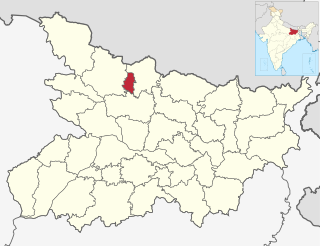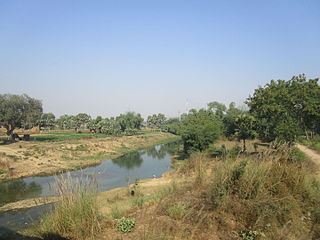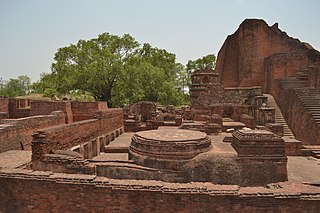
Shahjahanpur is a municipal corporation, town and district headquarters of Shahjahanpur District in Uttar Pradesh, India.

Gopalganj is one of the administrative districts in the Indian state of Bihar. The district headquarters is the town of Gopalganj, and the district is part of Saran Division. Major languages spoken are Hindi and Bhojpuri.

Sheohar is an administrative district in the state of Bihar in India. The district headquarters are located at Sheohar, and the district is a part of Tirhut Division. This district was carved out of Sitamarhi district in 1994 due to the extreme efforts of Raghunath Jha, former Union Minister. Eminent Hindi Novelist, Dr. Bhagwati Sharan Mishra was the first District magistrate of Sheohar . Sivas used to have a guest house in the Mehsi town of his time, which is still located in the name of Raja Bazar in East Champaran.The district occupies an area of 349 km2 and has a population of 656,246. Sheohar is known for its greenery and cleanliness. Cadamba and teak are the principal trees of this district. Nilgai or blue bull is the regional animal of this area.

West Champaran is an administrative district in the state of Bihar in India, located just 60 km (37 mi) west of Birgunj. It is the largest district in Bihar with an area of 5,228 km2(2,019sq mi). It is a part of Tirhut Division. The district headquarters are located in Bettiah. The district is known for its open border with Nepal. One of the major location in West Champaran is Kumar Bagh for SAIL Special Processing Unit and Bhitiharwa where Mahatma Gandhi started Satyagrah Aandolan.

Sitamarhi is one of the districts in the Mithila region of the Indian state of Bihar, India. Dumra is the administrative headquarters of this district. The district is a part of the Tirhut Division and is located along the border of Nepal.

Aurangabad district is one of the thirty-eight districts of Bihar state, India. It is currently a part of the Red Corridor.

Begusarai District is one of the thirty-eight districts of the Indian state of Bihar. The city of Begusarai is its administrative headquarters and is part of the Munger division.

Nalanda district is one of the thirty-eight districts of the state of Bihar in India. Bihar Sharif is the administrative headquarters of this district. The districts is home to the ancient Nalanda Mahavihara a UNESCO World Heritage Site. Nalanda is located in the Magadh region of southern Bihar.

Chatra district is district one of the twenty-four districts of Jharkhand state, India. The district was formed after separation from Hazaribagh district in 1991. Chatra is the administrative headquarters of this district. The district covers an area of 3718 km2.

Ayodhya district is one of the 75 districts in the northern Indian state of Uttar Pradesh. The city of Ayodhya is its administrative headquarters. The district occupies an area of 2,522 square kilometres (974 sq mi), and had a population of 2,470,996 in the 2011 census. Ayodhya district shares its borders with 6 districts of Uttar Pradesh. It is bordered by Gonda and Basti districts on the northern side, Amethi and Sultanpur districts on the south, and Ambedkar Nagar and Barabanki districts share the border on the east and west.

Siwan is a city and nagar parishad in the Indian state of Bihar. It is the administrative headquarters of Siwan district and one of the urban settlements out of three in the district. It is located close to Uttar Pradesh.

Bhojpur district is one of the thirty-eight districts of the Indian state of Bihar. Arrah city is the administrative headquarters of this district. Bhojpur district came into existence in 1972. Earlier it was the part of Shahabad district. This district is named "Bhojpur" after great Parmara King Bhoja as most early settlers were Rajput rulers of Parmara dynasty then called as Ujjainiya.

Jai Prakash University (JPU) is a state university located in Chhapra, Bihar, India. Initially serving the needs of higher and quality education of the people of Saran commissionary, it has completed its 29 years and has entered its 30th year. With 21 constituent colleges, 11 affiliated colleges and 23 proposed colleges including 10 professional colleges, it is offering courses at the undergraduate level and postgraduate level in most subjects.

Saran district is one of the thirty-eight districts of Indian state of Bihar. The district, part of Saran Division, is also known as Chhapra district after the headquarters of the district, Chhapra. It is considered as one of the richest Zamindari of Bihar after Raj Darbhanga, Hathwa Raj, Bettiah Raj and Raj Najarganj, Saran Raj.
The Bhojpuri people, also known as Bhojpuriya-sawb are an Indo-Aryan ethnic group from the Indian subcontinent who speak the Bhojpuri-language and inhabit the Bhojpur-Purvanchal region. This area is now divided between the western part of the Indian state of Bihar, the eastern part of the Indian state of Uttar Pradesh, western Jharkhand, along with some neighbouring districts in the Madhya Pradesh and Madhesh and Lumbini of Nepal. A significant diaspora population of Bhojpuris can be found in Trinidad and Tobago, Netherlands, Guyana, Jamaica, Suriname, other parts of the Caribbean, Fiji, South Africa, and Mauritius.
Tarwara is a village panchayat, and the most developed village located in the Siwan district of Bihar state, India, around 90.6 kilometres (56.3 mi) from Patna, the state capital. The other surrounding state capitals are Ranchi, Lucknow, and Gangtok.
Krishnaut or Kishnaut Ahir is a subclan of the Yadav (Ahir) caste found in Bihar, Jharkhand and Nepal.

















